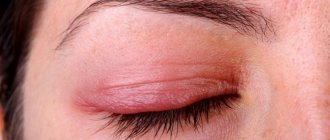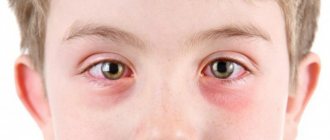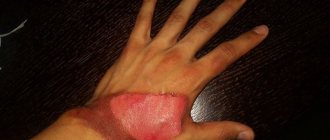Conjunctivitis in a child requires treatment at home; hospitalization is extremely rarely required - only when conjunctivitis is accompanied by a more serious systemic disease. Therefore, although only a doctor prescribes a treatment regimen for children, every parent should have the skills to treat this disease at home.
What can conjunctivitis be like in children?
Types of the disease are divided depending on the cause of its occurrence. The most common causative agents of the disease are bacteria and viruses; allergic conjunctivitis is slightly less common. Other forms, such as chlamydia, are extremely rare in children.
How to distinguish between different types of illness:
- bacterial. Its characteristic feature is eyelids sticking together in the morning and purulent discharge of a gray-yellow and greenish hue. In addition, the disease is characterized by painful sensations, itching and pain in the eyes. Typically, this form of conjunctivitis first attacks one eye and then moves to the other;
- viral. It most often accompanies ARVI and influenza with fever, fever, runny nose and inflammatory processes in the throat characteristic of these diseases. Additionally, tear production increases and the eyes itch. The discharge here is whitish, not purulent;
- allergic. Pain, itching, pain and swelling of the eyes manifests itself sharply, immediately on both organs of vision. The discharge is clear, not purulent. The disease goes away after the child is removed from the irritating object.
Treatment with folk remedies is most effective for bacterial and viral forms of conjunctivitis.
Kinds
Conjunctivitis is a disease that affects the mucous membrane of the eye, occurring in the form of an inflammatory process that may be accompanied by purulent discharge.
Depending on the pathogen, there are several types of conjunctivitis:
- Bacterial - occurs in 70% of cases, appears when staphylococci, streptococci or hemophilic bacteria come into contact with the mucous membrane of the eye. Microorganisms can be transmitted from a sick child to a healthy one. In addition, infection occurs when hygiene rules are not followed after playing outside in the sandbox or with animals.
- Viral - can occur independently (caused by adenovirus, herpes zoster, enterovirus, herpes, Coxsackie virus) or as a concomitant phenomenon of a serious disease. It could be measles, rubella, chickenpox, mumps, flu.
- Allergic - appears instantly when an allergen comes into contact with the mucous membrane of the eye. In rare cases, it is a reaction to food. These are mainly household allergens, pollen.
- Fungal - can be exudative or granulomatous. The cause is the proliferation of fungi located on the surface of the eye. Most often occurs with mechanical damage to the mucous membrane.
- Chlamydial - occurs when the microorganism Chlamydia trachomatis enters.
- Reactive - occurs in children with increased sensitivity of the mucous membrane to a number of chemical compounds. May occur after swimming in a pool with chlorinated water, or due to smoke or fumes.
Herbal medicine for conjunctivitis
Treatment with decoctions of medicinal plants can help with inflammation of the organs of vision that occurs with different types of conjunctivitis. They are used both in the form of rinses and as drops.
Let's look at recipes suitable for all forms of the disease:
| Healing plant | How to cook | How to use |
| Calendula, cornflower, nettle, comfrey | Pour two small spoons of any of the herbs (or a mixture in equal parts) with hot water and leave for a quarter of an hour. Filter. | For washing. |
| Chamomile, clover or sage | Infuse a large spoonful of dry plants in a cup of hot water for a quarter of an hour, strain and let cool. | For rinsing or compresses. |
| Aloe | Grind five fresh leaves in a blender and squeeze out the juice. Mix it with water in a ratio of 1:5. | For compresses. |
| The juice is mixed with water in a ratio of 1:10. | For washing. | |
| The juice is mixed with water in a 1:1 ratio. | For drops (one for each eye three times a day). | |
| Althea | Four large spoons of crushed roots are infused in cold water for eight hours. | For rinsing and lotions. |
| Eyebright | Infuse a large spoonful of ground herbs in a glass of hot water for an hour and filter thoroughly. | For compresses and rinses. |
If childhood conjunctivitis is caused by bacteria and the eyes fester, then you can try using rosehip decoction. The fruits need to be crushed and brewed in boiling water (a small spoon of the product per cup of water). Boil and leave for a quarter of an hour. With this decoction you can wash your eyes from pus and make lotions.
Also, purulent bacterial conjunctivitis is well treated with rinses and lotions based on echinacea decoction. The decoction is prepared in the same way as the previous recipe; the roots of the medicinal plant must be crushed beforehand. This drug can also be taken orally: drink two large spoons four times a day.
Many folk remedies recommended for conjunctivitis contain dill herbs or seeds. For example, mix dill, marshmallow root, horsetail, rose petals and chicory flowers. The last two ingredients are taken in double volume. For a cup of water you will need three large spoons of the vegetable mixture. After boiling for five minutes, the broth must be cooled and filtered. The composition is instilled into sore eyes three times a day (three drops for each organ of vision).
Treatment of conjunctivitis is also carried out using freshly squeezed dill juice. It is applied to cotton pads and ten-minute compresses are made several times a day. It is useful to remove purulent discharge in children with a swab dipped in a decoction of dill seeds (a teaspoon per cup of boiling water).
Adviсe
- Rinse your eyes properly. The movements should be in the direction from the temple to the nose, and not vice versa.
- Carefully filter rinse and lotion solutions. Since most folk recipes are prepared from crushed plant materials, you should take a very responsible approach to filtering solutions to prevent even the smallest plant particles from getting into the sore eye.
- Do not stop treatment abruptly. If you notice improvements and the redness has almost disappeared, you should not stop treatment immediately. Symptoms of conjunctivitis disappear gradually, and therefore it is recommended to continue therapy for another 2-3 days after cure.
- Provide your child with a separate towel and dishes. Remember that in 90% of cases, conjunctivitis is very contagious; to protect other family members, provide the sick person with individual things to avoid infecting others through everyday life.
Watch the following video, which talks about popular folk remedies for treating conjunctivitis.
medical reviewer, psychosomatics specialist, mother of 4 children
Conjunctivitis is an inflammatory process in the mucous membranes of the eye, also affecting the eyelid. The disease is very common and it poses a danger to people of any age.
The causes of conjunctivitis are associated with bacterial, viral and allergic factors .
There are many methods offered by official medicine to treat the disease, but folk remedies are also effective for restoring the conjunctiva. One of the remedies that help with inflammatory disease is tea.
Other Alternative Medicine Treatments for Conjunctivitis
Homemade folk remedies that can be used to treat this disease in children can be found in any kitchen.
Our great-grandmothers used such folk methods against conjunctivitis:
- Tea brewing. You can use freshly brewed green or black tea for rinses and compresses. Old tea leaves cannot be used - it becomes toxic.
- Rose petals. Useful if the child has bacterial or viral conjunctivitis. A large spoonful of petals should be infused for 30 minutes in a cup of boiling water, then filtered. The drug is used for rinsing and lotions.
- Tea mushroom. It restores the body's defenses. The liquid can be drunk or used for rinsing and lotions.
- Blueberry. You can eat it fresh or brew dried berries as tea and drink half a cup five times a day. The decoction is also recommended for washing festering eyes in children.
- Bay leaf. Three things need to be turned into powder, pour a glass of boiling water, filter. Use for rinsing and lotions.
- Propolis. Pharmacies sell propolis water, which can be dropped into a child’s eyes three times a day. It’s easy to prepare the composition at home. To do this, fresh propolis is ground into powder, diluted with water (1:5) and carefully filtered.
- Honey. Eye drops are created from this sweet beekeeping product (one drop for each organ of vision at night). You need to mix liquid fresh honey in a 1:2 ratio with water. The solution can also be used for compresses.
- Egg white. It is mixed with water (two proteins are needed per 500 ml), then lubricated with inflamed organs of vision half an hour before going to bed.
- Raw potatoes. It is ground on a grater or in a blender and mixed with egg white. Used as a compress (wrap in gauze).
- Cottage cheese. They treat conjunctivitis with the help of compresses, wrapping the cottage cheese in a gauze shell.
- Fresh cucumber. The juice is squeezed out of the vegetable and used as a lotion.
If a child has bacterial, and especially viral conjunctivitis, you can try treatment with garlic vapor. You need to grind a few cloves and inhale, leaning over the container with the pulp through your nose. You need to exhale through your mouth. Similar procedures are carried out after washing.
Treatment with traditional methods is possible only after consulting an ophthalmologist in combination with medications. It is recommended not to use only one drug, but to alternate decoctions.
Conjunctivitis is a fairly common disease of the mucous membrane of the eye. Most often, this type of inflammation is caused by viral or bacterial infections and all kinds of allergic reactions. In almost all cases, the patient's eyelid swells and conjunctival hyperemia occurs, lacrimation, photophobia and intense redness of the white of the eye appear. Suitable therapy is usually prescribed by an ophthalmologist, but treatment of conjunctivitis with folk remedies is considered no less effective and efficient.
Features of treatment of newborns
Newborns also sometimes suffer from conjunctivitis. An infant can become infected with an infectious form while passing through the birth canal if the mother has a sexually transmitted infectious disease, such as chlamydia. In case of infection, symptoms appear in the first days after birth, while still in the maternity hospital. Sometimes the infection occurs due to non-compliance with hygiene rules.
Features of treating conjunctivitis in newborns at home are as follows:
- Not all medications are approved for use in infancy. Before use, you need to make sure that the drug can be used for infants.
- Baby's sensitive eyes require careful handling. Do not press or rub your eyes when rinsing.
- If the baby cries and closes his eyes, not allowing the drops to drip in, just drop the medicine on the closed eyelid and do not let him turn his head until the eye opens. Then the medicine will automatically reach the mucous membrane.
- If there are any changes or signs of worsening, see your doctor again.
The baby's immunity is still weak, so you need to monitor pathological manifestations at home especially closely.
How does conjunctivitis manifest?
- Bacterial conjunctivitis almost always affects both eyes and is easily transmitted from one person to another. Irritation occurs due to non-compliance with the simplest and most familiar rules of personal hygiene. The disease can be triggered by touching the eyes with not very clean hands or even simply by being in a very dusty, poorly ventilated room.
- Viral conjunctivitis first attacks only one eye, and only then moves to the second. Typically, this form of the disease occurs with a classic seasonal cold or when affected by an upper respiratory tract infection. First, a pain appears in the corner of the eye, then the vessels turn red and the conjunctiva becomes inflamed. The remaining symptoms manifest themselves differently for everyone and mostly depend on the general condition, age and level of immunity of the person.
- Allergic conjunctivitis in almost all cases is seasonal. The most common pathogen is pollen from certain flowering plants. However, household dust, pet hair and other allergens can just as easily trigger the disease. Allergic conjunctivitis is not transmitted from person to person and does not pose any danger to others.
Types of conjunctivitis
Children of preschool and school age are most vulnerable to the bacterial form of the disease, adults are most vulnerable to the allergic form. Viral conjunctivitis is equally dangerous for both a child and an older person. Having noticed the first symptoms, measures should be taken immediately and the issue of healing should not be put off for a long time. A mild inflammation process very quickly becomes chronic and requires much more complex treatment. Folk remedies for severe conjunctivitis will no longer help and you will have to resort to serious drug therapy, in special cases - at the hospital level.
Treatment of conjunctivitis at home
The main treatment procedures to help get rid of conjunctivitis are eye washing, compresses (lotions) and instillation of drops. You can buy suitable products at the pharmacy, but many patients prefer to prepare medications right at home from natural herbs and natural ingredients. Official medicine does not prohibit this, but insists that patients begin treating eye conjunctivitis with folk remedies only after visiting a doctor.
The best folk recipes
Aloe leaf juice is effective for conjunctivitis
- Treatment of conjunctivitis with folk remedies in adults often begins with the use of a mild aloe vera. To prepare, you need to squeeze the juice out of 5 fleshy, dense leaves and mix it with regular boiled water in a ratio of 1:10. Soak a cotton pad in the liquid and apply it to the affected eye for 10-12 minutes. Repeat 3-4 times a day for at least one week.
Rose petal compress soothes sore eyes
- Crushed marshmallow root (4 pieces), poured with boiled water (200 ml) and infused for 8 hours, is excellent for washing the eyes. It is recommended to use the composition at least twice a day.
- A decoction of dry, finely chopped rose petals (1 tbsp) is often used as an impregnation for a soothing compress. They are steamed with 230 ml of boiling water and infused for half an hour. You can use the same product to wash your eyes several times a day.
- Such a simple folk remedy as cucumber juice will help relieve acute inflammation and quickly cure viral conjunctivitis. You need to dip cotton pads in it and apply them to your eyelids 2-3 times a day for 15-20 minutes.
Honey drops kill conjunctivitis bacteria
- Drops prepared from 1 tbsp help effectively fight conjunctivitis. l liquid honey and 2 tbsp. l clean filtered water. The same mixture can be used as a daily compress.
Prevention of childhood conjunctivitis
Most often, children suffer from this disease. While playing on the street, on the playground or in kindergarten, the child unconsciously touches his face and eyes with dirty hands.
Through direct contact, the infection instantly reaches the mucous membrane. Inflammation makes itself felt sharply, and symptoms are observed almost on the same day.
The first action in this case is an urgent visit to the doctor. The ophthalmologist will assess the extent of the disease and prescribe treatment for how to treat the patient.
The child must be checked for allergies to plants and pollen. And only after the approval of a specialist, traditional medicine can be included in treatment.
Of the many folk remedies in the fight against childhood conjunctivitis, there are several that are most effective.
Aroma oils
A variety of oils have an anti-inflammatory effect, and their scents will help relax the child and distract him from painful sensations. The procedure is also suitable for adults. You can prepare compresses from the following oils:
- Chamomile;
- Almond;
- Lavender;
- Rosemary;
- Pink;
- Any conifer.
You need to drip a few drops of oil onto a clean, warm cloth, then apply the compress for 20 to 30 minutes. Contact with pine oils should be a little shorter, about 15 minutes, since pine needles have too strong a smell. It is not recommended to apply aromatic compresses to newborns. Babies develop perceptions, including a sense of smell, the development of which does not need to be interfered with.
The medicinal properties of aloe are varied. The juice of the plant has an antiseptic effect, thanks to salicylic acid and vitamins B and C in the composition. Calms thanks to magnesium and manganese. The enzyme contained in aloe heals mucosal wounds.
A solution is prepared from large leaves of the plant. Aloe juice should be mixed with purified or boiled (cool) water. Ratio 1: 10. Place 1 drop in the child’s eyes once a day.
Bay leaf
The spice is used as a remedy for swelling of the eyelids due to conjunctivitis. Adults can make lotions, and for children it is enough to simply rinse their eyes with the infusion 3 to 5 times a day. To prepare water for washing, you need to pour boiling water over 3 large leaves and leave for half an hour.
The main treatment procedures used for conjunctivitis are instillation of drops, lotions and eye washing. You can use both pharmacy and folk remedies for conjunctivitis in children, but when using the latter, it is also important to consult a doctor.
For bacterial conjunctivitis, drops such as Sulfacyl sodium, Torbex, Floxal may be indicated. If the disease is of an allergic nature, Lecrolin eye drops are popular and are prescribed to children over four years of age.
Eye lotions and washes can also be effective for conjunctivitis.
Folk remedies are most often used for lotions. Boric acid, castor oil, black tea, dried chamomile flowers, bay leaf are used.
An interesting fact is that rinsing the eyes with cold boiled water reduces irritation. For this procedure, you need to prepare water in advance and lower your face into it for a few seconds. You can also put water in your hands and splash it in your eyes. Repeat this action several times.
During the acute period of the disease, specialists often prescribe vitamin complexes, which make it possible to strengthen the immune system and ensure rapid recovery. Within a month from the onset of the disease, it is recommended to use effervescent vitamins or vitamin tablets. Vitamin C is especially useful - it strengthens the walls of blood vessels and helps effectively fight any infection.
Some folk remedies have also proven themselves to be effective in the fight against conjunctivitis. Despite their safety, a doctor must also give the go-ahead for such treatment.
Parents need to take into account that with this disease, it is not advisable for the baby to be in a room where the air is very dry. It is also important to try to limit contact with household chemicals, especially those containing chlorine and its derivatives.
It is necessary to rinse and apply drops to both eyes - both the sick and the healthy. Use different cotton pads on your eyes to prevent the infection from spreading from one eye to the other.
You cannot warm up your eyes or apply warm complexes and bandages, especially if the disease is bacterial in nature, since heat is a favorable environment for the proliferation of microbes.
Sometimes conjunctivitis can be easily and successfully cured at home and even using folk remedies. But it is important that all measures are approved by a doctor.
Treatment of conjunctivitis in children with folk remedies
Young children are most susceptible to bacterial conjunctivitis. Most often, the problem arises due to the fact that a child touches his eyes with dirty hands while playing or on a walk and thus introduces an infection there. Symptoms of the disease in children develop very quickly, so the issue cannot be delayed and you need to visit a doctor as soon as possible and find out whether it is possible to treat childhood conjunctivitis with folk remedies or whether only drug therapy is necessary.
Children's conjunctivitis is often provoked by dirty hands
If the ophthalmologist has given the go-ahead for the use of compresses, rinses and drops made from natural ingredients, take note of the following recipes:
- Soothing compresses. To do this, you will need to brew loose leaf tea to medium strength and leave for 1 hour. Before use, warm the prepared liquid to a comfortable temperature and rinse the swollen eyelids with it. The product is gentle and gentle, so you can use it up to 5 times a day.
- Chamomile (1 tsp) steamed with boiling water (1 tbsp) can help eliminate viral inflammation of the conjunctiva in a child. The broth must be left for 2-3 hours, drained, moistened with gauze and applied to the baby’s eyes. The procedure can be repeated up to 4 times a day.
Chamomile decoction for the treatment of conjunctivitis
- You can quickly overcome the infection by pounding rose hips (3 tsp) in a mortar and brewing with 250 ml of boiling water. Then the mixture needs to be heated for 10-15 minutes in a water bath and allowed to brew for half an hour. Apply warm to the eyes 3-4 times a day.
It is quite possible to cure conjunctivitis with folk remedies, but they act quickly and effectively only in mild forms of the disease, or can be used as prophylaxis or accompanying procedures. For serious systemic treatment, you must contact an ophthalmologist and strictly follow all the instructions he gives.
Forms of the disease
There are many recipes for treating the disease, but the choice of remedy depends on the reason for which conjunctivitis developed.
The following forms of the disease are distinguished:
| Adenoviral | Adenovirus, more common in children | Airborne, the disease is epidemic in nature |
| Herpetic | Herpes virus | Other people's hygiene items, dirty hands |
| Allergic | Allergen | The reaction occurs instantly |
| Spicy | Coccal flora | Unwashed hands, hypothermia, overheating, microtrauma, myopia or astigmatism |
| Acute epidemic (Koch-Wicks) | Koch-Wicks wand | Airborne droplets, dirty hands, dust, wind, bright sunlight, observed mainly in the warm season |
| Blenorrheic in newborns | Gonococcus | From a mother infected with gonorrhea during childbirth |
| Morax-Axenfeld (angular) | Diplobacillus Morax-Axenfeld | Transmitted through personal hygiene items of an infected person |
| Chronic | External irritants - dust, chemicals, internal factors - vitamin deficiency, metabolic disorders, pathologies of the lacrimal ducts, ENT organs, ametropia | |
| Toxic | Caused by exposure to toxins in the mucous membrane of the eye |
There are many ways to quickly cure conjunctivitis. But the treatment is selected by an ophthalmologist based on the diagnosis.
Video - Conjunctivitis: symptoms and treatment
Symptoms
The disease can have an acute or chronic form. Depending on this, the symptoms that accompany conjunctivitis in infants and older children differ.
Acute form
- Burning;
- Pain in the light;
- Discharge of purulent contents;
- Swelling of the eyelids;
- Lethargy, increased body temperature;
- Profuse lacrimation.
Chronic form
- The above symptoms are aggravated by exposure to sunlight or electric lighting;
- Cloudiness of the cornea;
- Sensation of a foreign body (sand) in the eyes;
- lacrimation;
- Slight heaviness in the eyelid area.
Drug therapy
The first line of therapy prescribed for conjunctivitis involves the use of traditional medicine.
Before proceeding to treatment with ointments and gels, the eyes are washed with an antiseptic, for example, furatsilin . To do this, two tablets are crushed and dissolved in a glass of boiling water, and the liquid is allowed to cool to body temperature. The solution is filtered through a sterile bandage to remove solid particles that can injure the mucous membrane.
Important! For each wash, prepare a fresh solution of furatsilin, especially if it is used to treat children.
The procedure is carried out as follows:
- Wash your hands thoroughly with soap, you can additionally treat them with an antiseptic - for example, chlorhexidine digluconate.
- Make a tampon from sterile cotton wool, soak it with furatsilin and squeeze out the excess moisture a little.
- The lower eyelid is pushed back with a finger and the eye is carefully treated, moving from the inner to the outer corner of the eye.
In case of conjunctivitis, it is necessary to rinse the eyes with furatsilin solution
It is allowed to use special devices - eye cups, rubber bulbs. The pharmacy also sells eye baths. Before each use, boil the accessories or take new ones if the products are intended for one-time use.
For conjunctivitis with abundant purulent discharge, drops of sodium sulfacyl, chloramphenicol . The crusts that have formed on the eyes are removed, after which they are washed with an antiseptic solution. Herpetic rashes are treated with brilliant green.
If rinsing is not enough, additionally use gels, ointments, and creams. The following types of medications may be prescribed:
- antihistamines;
- corticosteroids;
- non-steroidal anti-inflammatory drugs;
- local antibacterial;
- artificial tear.
Acyclovir ointment for the treatment of conjunctivitis
For different forms of conjunctivitis, the following drugs are used:
- viral - medications based on tebrofen, oxolin, as well as interferon or other products that stimulate the immune system;
- herpetic - ointments Acyclovir, Virolex, Zovirax, as well as Bonafton, Florenal ;
- Tobrex drops (for staphylococcal infection), Chloramphenicol , ointments Brulamycin, Tobrex, Colbiocin, Sulfacetamide, Gentamicin, Tetracycline, Polyfax, Framycetin, Polytrim, Garazon, Tobradex, Sofradex ;
- allergic - Hydrocortisone .
In addition to local treatment, in some cases oral medications are indicated. So, for herpes, the antiviral drug Valtrex and the immunomodulator Cycloferon . Allergic forms require the appointment of Zyrtec, Suprastin .
The dosage of the drugs, method of administration and duration of therapy are indicated in the instructions.
Tobrex drops for the treatment of bacterial conjunctivitis
When the body's defenses are weakened and there is a lack of vitamins, vitamin-mineral complexes are prescribed.
Diet therapy
If the cause of conjunctivitis is a weakening of the body’s defenses due to vitamin deficiency, then doctors recommend including plant foods rich in carotene in the diet. This substance is converted into vitamin A, or retinol, which is known for its antioxidant properties. Lack of retinol negatively affects visual function: color perception and vision in the dark deteriorate, the cells of the cornea and conjunctiva dry out, which increases the risk of conjunctivitis. The recommended daily dose of vitamin A is 6–15 mg.
Rich in carotene:
- carrot;
- parsley;
- dill;
- red rowan;
- apricot;
- blueberry;
- rose hip.
Important! If chronic conjunctivitis has developed, traditional healers recommend consuming one tablespoon of blueberries daily - fresh, frozen or dry.
Spinach, corn, broccoli, onions, garlic, seeds, nuts, sprouted wheat grains, citrus fruits, and beets are also good for the eyes.
Foods High in Vitamin A
In its pure form, vitamin A is found in animal products - fish oil, caviar, beef liver, eggs (yolk), milk and its derivatives - butter, sour cream, cottage cheese, etc.
Diet therapy requires giving up the following foods:
- very salty foods, which increase eye dryness and cause irritation;
- alcohol, which impairs the absorption of nutrients, in particular riboflavin, or vitamin B2;
- sweets, flour products, provoking processes of fermentation, rotting, worsening the condition of the eyeball;
- finished products with preservatives.
It is recommended to reduce the daily dose of coffee: too much caffeine causes the blood vessels in the eyes to narrow. Excessive consumption of protein foods causes sludge in the body, which leads to increased eye pressure.
Traditional medicine recipes
Traditional medicine recipes are effective in treating conjunctivitis. But it should be remembered that these drugs are allowed as auxiliaries and only after consultation with a doctor.
Important! If conjunctivitis is caused by allergens, you should carefully use the following recipes, especially those that involve bee products.
To quickly get rid of inflammation of the conjunctiva, use the products internally and externally - in the form of lotions and compresses (the duration of the procedure is 10-20 minutes), rinsing.
Video - How to treat conjunctivitis in children and adults
Colloidal silver
For treatment, especially when the disease is of bacterial origin, colloidal silver is used. This is a liquid solution with silver nanoparticles. This remedy was used by obstetrician-gynecologist Karl Crede to prevent blenorrhea in newborns.
Important: the smaller the size of the colloidal particles, the more pronounced the therapeutic effect.
The drug is poured into the conjunctival sac 1-2 drops 2 to 4 times a day. If the patient wears contact lenses, they are removed, the procedure is performed, and the optical elements are put back in place. Drops are used until complete recovery.
Carrot
To eliminate the lack of vitamin A, it is enough to consume 167 g of red carrots every day. However, it should be remembered that fats are needed for normal absorption of retinol, so salads are seasoned with vegetable oil, sour cream, and yogurt.
Freshly squeezed juices are prepared from carrots (4 parts) and greens - parsley, celery, lettuce (1 part each). Take 100 ml of the drink on an empty stomach, half an hour before meals, 1-3 times a day, through a straw. If headaches occur with a high dosage, then the number of doses is reduced. The course is one month. If necessary, after a month's break the treatment is repeated.
Tea brewing
Tea contains antioxidants that protect against germs when rinsing the eye
Probably the most common recipe for conjunctivitis is rinsing the eyes with tea leaves. The healing effect of tea is due to the content of antioxidants that protect against microbes. The variety is taken black or green and brewed as usual.
Important! Tea must be fresh, of high quality, without aromatic additives, admixtures of other herbs, sugar, or lemon. The temperature of the liquid is close to room temperature.
After general washing, take a piece of sterile cotton wool and soak it in brewed tea. The procedure is carried out like this. Bend over the washbasin and run a cotton swab over the closed eye, from the outer corner to the inner one. The manipulation is repeated several times with a fresh swab.
After washing, carefully dry the eyelid skin with a clean towel (preferably disposable). Do not wipe your eyelids dry, as the skin on them is delicate and can be easily damaged. The procedure is carried out up to five times a day until the disease subsides.
The recipe is even used to treat infants, but only after the doctor’s permission. Brewing black tea will also help in everyday life with redness due to eye fatigue, for example, after working at the computer for a long time.
Bay leaf
Bay leaf is distinguished by its antiseptic properties
Bay leaf has antiseptic properties, improves immunity, and contains vitamins A and C.
Take four large bay leaves, wash with clean water and chop. Dry raw materials are poured with one glass of boiling water and allowed to brew for half an hour, cooled to room temperature. Use the infusion for rinsing (twice a day) or lotions (the bandage is soaked in the product and applied to the eyes for 20 minutes). Eyes are washed with laurel infusion as described above. Apply lotions until the symptoms of conjunctivitis disappear.
Rose petals
Rose has long been used to treat skin and eye diseases. Carotene, vitamin C and the entire periodic system were found in its petals.
To prepare a remedy for conjunctivitis, take a tablespoon of the plant’s petals, wash it, and pour a glass of boiling water. The infusion is ready in 30 minutes. Wash your eyes with it up to 5 times a day, make 30-minute compresses before bed. Rose water eliminates burning and pain. It is also used after work to relieve fatigue. Treatment is continued until the condition improves.
Marshmallow root
Marshmallow root helps with inflammatory diseases of the ENT organs
Marshmallow root is used primarily for inflammatory diseases of the ENT organs. But the water infusion is also useful for conjunctivitis. This is how they prepare it. Boil water, cool to room temperature. Four tablespoons of marshmallow root are poured into a glass of cold water and left for eight hours. Lotions and rinses are made from the infusion (the procedure is carried out as with tea leaves) 3-4 times a day until complete recovery.
Bee products
For old conjunctivitis, bee glue (propolis) is effective. For eye treatment, an aqueous solution (20%) is prepared from it. Water is taken after boiling, cooled to 50 °C, since at higher temperatures beneficial substances are destroyed. The solution is strained to remove solid particles. This infusion is instilled into the eyes every three hours (dosage - 2-3 drops in each eye). Treatment is continued as long as symptoms persist. Propolis has pronounced bactericidal and cleansing properties.
Propolis is effective for old conjunctivitis
Royal jelly is used for treatment. An aqueous solution of this bee product (2% concentration, based on distilled water) is passed through filter paper or a sterile bandage folded in 2-3 layers. The solution is instilled into the eyes for various forms of conjunctivitis (with the exception of allergic) 2-3 drops into each eye 5-6 times a day or lotions are made with the same frequency. The course of treatment is 10-20 days. Royal jelly improves tissue regeneration, blood circulation, and also fights pathogenic bacteria, inhibits the growth of microbes, and is effective against staphylococci and tubercle bacilli. For conjunctivitis, it is no less useful to take medications based on royal jelly orally to strengthen the immune system and saturate the body with vitamins and minerals, essential acids.
With reduced immunity, take pollen internally - half or one teaspoon up to 3 times a day. The course of treatment is 3–4 weeks.
The main causes of conjunctivitis
First, let’s define what this disease is. Conjunctivitis is an inflammation of the mucous membrane of the eye, which is characterized by an inflammatory reaction of the conjunctiva, the thin transparent film of the eye, to infectious, viral or allergic processes in the body.
As a result, the protective and barrier functions of this film are reduced, which leads to an inflammatory process. This disease is especially common in children in the autumn-spring period, since it is during these times of year that a small organism is most susceptible to the influence of environmental changes.
The main causes of the disease include the following factors:
- allergic reactions that occur to a specific irritant, for example, pollen or house dust.
- exposure to ultraviolet radiation for a long period of time;
- sensitivity to certain medications;
- hypothermia or overheating of the eyes;
- chronic diseases of the ears, throat or nose, which are permanent and worsen in cold seasons, for example sinusitis, the treatment of which at home should be approached with special attention in order to quickly avoid exacerbations and complications, as is the case with the treatment of sore throat .
- vitamin deficiency, due to a lack of nutrients and vitamins entering the body;
- eye strain due to long periods of working on a computer or phone;
- exposure to viruses or infections in the eyes.
Did you know? It should be borne in mind that with allergies, in addition to irritation of the mucous membrane of the eye, allergic rhinitis, rashes on the skin or certain problems with the respiratory system occur, which, in turn, complicate the diagnosis of conjunctivitis in children and the method of its treatment.
How to avoid re-infection?
It is important to prevent re-infection of the conjunctiva, otherwise the likelihood of an acute process becoming chronic increases. To do this, it is enough to follow these rules:
- Strengthen the body's defenses.
- Normalize the diet, enrich it with foods containing vitamin A.
- Treat infectious diseases of the oral cavity and nasopharynx in a timely manner.
- Follow the recommendations for caring for contact lenses and glasses.
- Avoid contact with allergens if you are prone to frequent allergic conjunctivitis; during the season of exacerbation of the disease, use medications prescribed by your doctor.
- Avoid touching your face and eyes during the day; change lenses after disinfecting your hands.
- Ventilate the room.
- Change bedding regularly.
- Wash only with boiled water.
- Wash children's toys with soap.
To avoid spreading the infection to other family members, you should use only your own toiletries and bedding.
Strengthening the child's immunity
To reduce the incidence of illness in children, it is important to strengthen their immunity in accessible ways. For this it is recommended:
- Temper the child by walking with him in any weather and often ventilating the rooms.
- Going to the pool with your baby, nothing increases the vitality of the body like water procedures.
- Dress children according to the weather: children who are constantly bundled up are more susceptible to various infections.
- In the summer, go with your children to the forest or to the sea for at least a week.
- Do morning exercises and follow a daily routine.
- Enroll your child in a sports section.
A contrast shower will also help strengthen your immune system. It is recommended to do it every day, alternating hot and cool water.
Children's menus should include a lot of fresh vegetables, fruits and herbs. In the off-season, you can take a course of vitamin preparations.











